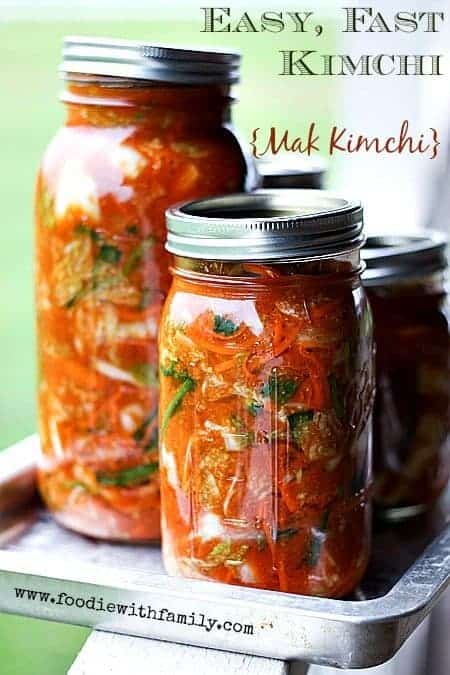
Love this Easy, Fast Mak Kimchi recipe? Check out our other fabulous Korean Food Recipes!
If you’ve been with me for a while, you’re well aware of my undying love for kimchi. Yes, it is stinky and bubbly and more than a little wild, but WOWZA the taste and the texture are so worth it.
If you’re new to the Foodie with Family family and you aren’t familiar with kimchi, I can give you a super condensed description; it’s essentially spicy, aromatic Korean sauerkraut. Today, I’m bringing you a fool-proof Easy Fast Kimchi recipe {Mak Kimchi}.
What is Kimchi?
Kimchi comes in almost as many forms as there are vegetables because nearly any vegetable can be fermented. They range from super mild smell to mega funky and mellow to melt-your-face-off spicy and there is one for every possible point in between.
The kimchi recipe that I’m sharing today is my family’s favourite version. It’s chock full of fabulous pro-biotics (as most kimchi is) and the longer it ages (translation: ferments) the stronger it becomes in both flavour AND pro-biotic content.
It’s like yogurt on steroids, people. That’s how good it is for you!
Is Kimchi Good For You?
Health Magazine named kimchi one of it’s Top 5 World’s Healthiest Foods. It is is low in calories and fat and high in dietary fiber and wicked high in Vitamins A, B, and C.
Many (if not most) Koreans eat a little kimchi with each meal or at least once a day. Kimchi is credited with helping most Koreans avoid obesity by virtue of its ability to satisfy even while being low calorie and low fat.
Seoul National University conducted a study and claimed that chickens infected with the H5N1 virus, also called avian flu, recovered after eating food containing the same cultured bacteria found in kimchi. That’s good enough for me!
How to Make Kimchi
Let’s get cracking and make some kimchi, shall we? The variety we’re making today is an Easy, Fast Kimchi recipe or Mak Kimchi…
In other words, it’s already cut up and ready to shovel into your mouth. Unlike what is usually just called ‘kimchi’ which is whole heads of napa cabbage smeared with the kimchi paste and allowed to ferment all wrapped up.
This version is FAR easier to make and far faster to be ready. Bonus, it is way easier to eat straight from the jar with a pair of chopsticks or a fork.
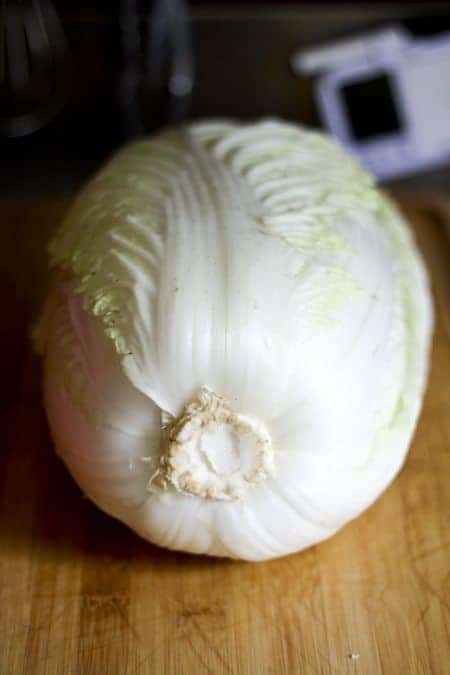
Do I need special tools to make kimchi?
In short, no. All you really need is a knife, a cutting board, and a big bowl. You will need a couple of ingredients that you may not have purchased before, but never fear, they’re not hard to find these days and I’ve included links to them below.
To begin with, you’ll need a big old head or two of Napa cabbage. I had two heads like the one above weighing in at about 3 pounds each.
It yielded, when all was said and done, about 3 quarts of kimchi, so that was perfect for me. You can cut that back if you think you can’t consume that amount of our Easy, Fast Kimchi recipe or Mak kimchi.
But I find all sorts of places to tuck it in, so it’s not an issue here and it’s only my husband, myself, and two of our boys who eat it. We love our kimchi.
Kimchi Recipe
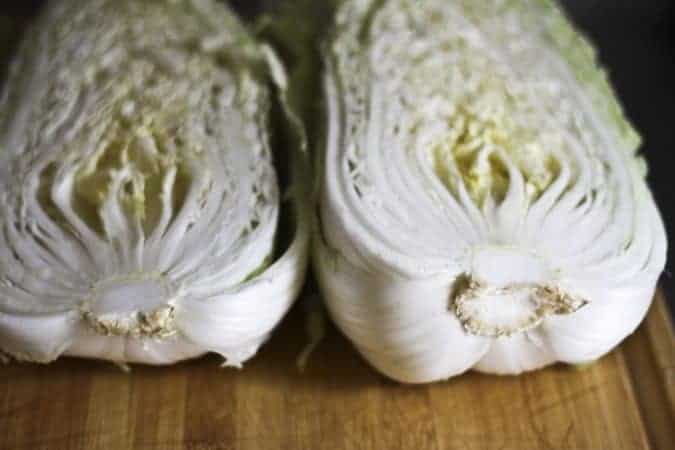
Lob your cabbages in half lengthwise. Use a paring knife to remove the gnarly core from them before cutting in half lengthwise again, leaving you with quarters.
Cut across the quarters to make bite-sized squares of cabbage. I usually shoot for 2-inch squares.
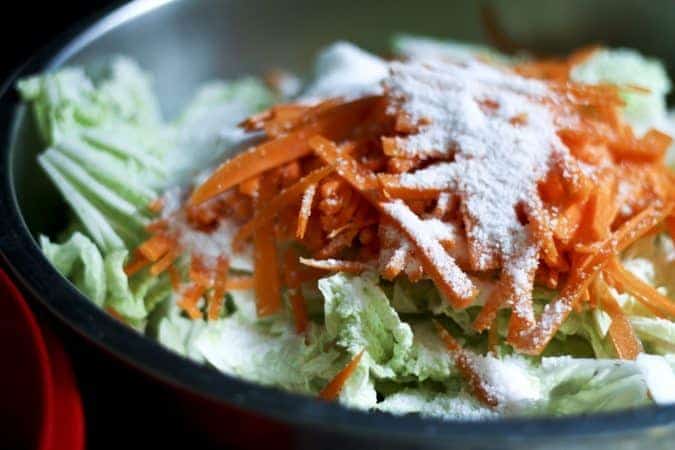
Add the cabbage to a monstrously huge bowl (or bowls), top with the julienned carrots, and sprinkle salt over the whole works. Toss the veggies and massage the mixture until the cabbage just starts to wilt.
Pour in enough cold water to over all the cabbage and carrots by a bit. It doesn’t have to be swimming in water, just covered.
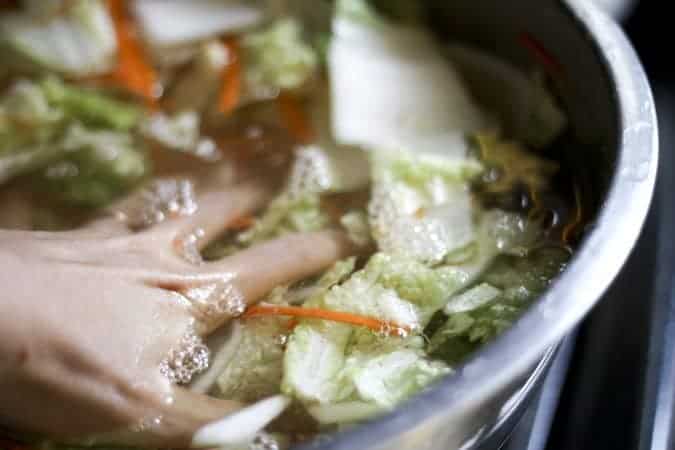
Stir it up with your hands and let it rest at room temp for a couple of hours.
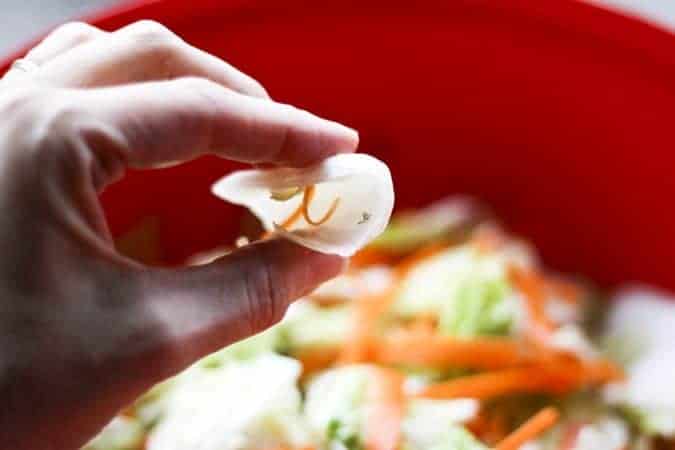
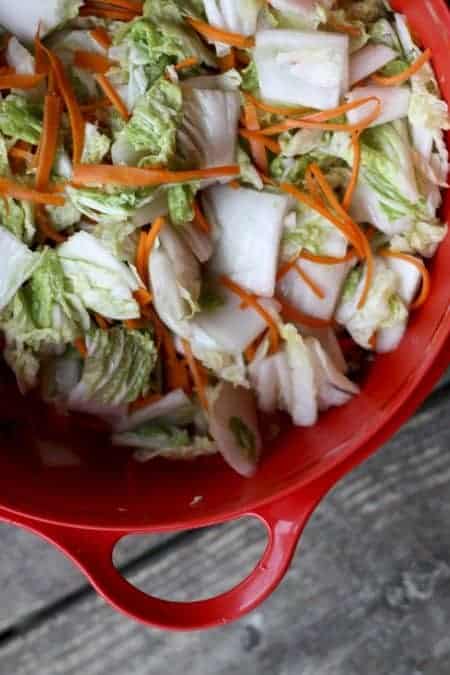
After a couple of hours, when the sturdier pieces of cabbage have become flexible, pour the whole lot into a strainer and let the brine water drain away.
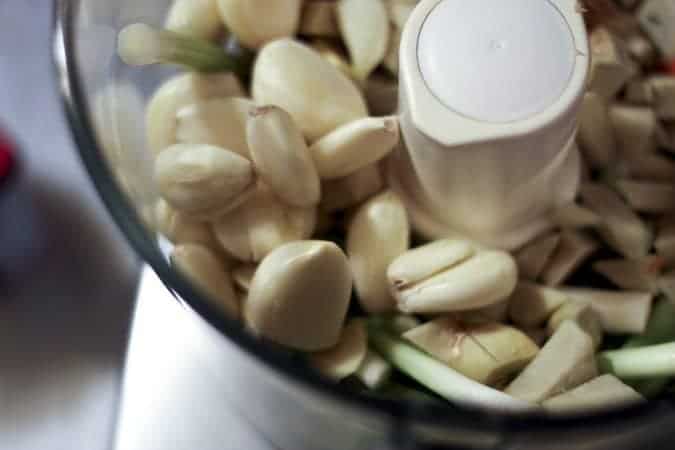
Now you’re going to whizz up the good stuff. Garlic, ginger, the white parts of scallions, Korean Red Pepper Powder*, fish sauce, unsweetened pear or apple juice, miso paste, and whatnot go into the food processor or blender.
Obliterate and smash it all into a lovely, red, fabulous smelling paste. It’s worth noting that you shouldn’t just up and increase the garlic because it can make kimchi linger more on your breath than you’d like it to do.
It also tastes out of balance if you add a lot more. Be aware.
And by the same token, you shouldn’t increase the ginger willy-nilly because that can make the final product a little more bitter than you’d like it to be. Start with the mixture and proportions I’m giving you and then play with it in subsequent batches.
*It’s important to note that you cannot use American or Mexican Chili Powder in place of the Korean pepper powder here. They’re COMPLETELY different animals. It may end up tasty, but I haven’t tested it so I cannot speak to it.
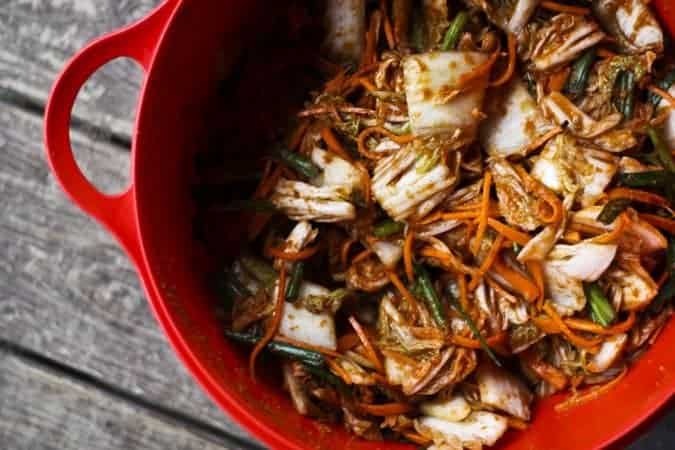
Now you’ll CRAM this stuff into jars or food-safe plastic containers. When I say cram it, I mean shove it in there as firmly as you can without putting your fist through the bottom of the jar.
I do prefer glass canning jars, if you’re wondering, because they don’t retain odors like plastic does, and, well, this stuff is odiferous! You can use a dedicated plastic kimchi bucket if you’d prefer, though.
Gently place a lid and ring on the jar, but don’t screw it tightly into place because BOOM. It’ll pop. This is active stuff, mes amies!
Place the jar on a rimmed pan or baking dish. The rim is pretty crucial here, because as the kimchi ferments at room temperature (and more slowly but still actively in the refrigerator) it will bubble up and may release a little juice over the edge of the jars.
In other words, you could have a kimchi river a-flowin’ on your counter top unless you take precautions. It’s easiest to use the pan and not worry about your Easy, Fast Kimchi recipe or Mak Kimchi bubbling over onto your counters.
It’s going to spend a couple of days at room temperature getting bubbly and fragrant. Every day, you’ll insert a clean chopstick or butter knife into the jar to help release air bubbles and top the jar off with extra brine if needed to keep everything submerged.
When it’s almost carbonated looking (usually between 24-72 hours after packing the jars), it’s ready to refrigerate. I highly recommend refrigerating it on the tray you used to contain the Grand Kimchi River while it fermented.
There aren’t a lot of things quite as unnecessary as removing everything from a fridge and mopping kimchi juices off of it. Take my word for it.
How long can I keep homemade kimchi?
It’s ready to eat at that point! Of course, it gets stronger and more kimchi-y the longer it sits. I love cooking with the older stuff and eating the newer stuff ‘raw’.
One of my all-time best-loved ways to eat older kimchi is in pancake form. Not like Aunt Jemima pancakes or flapjacks, but savoury, crispy-edged, kimchi-studded, pan-fried, snack cakes that convert even die-hard kimchi skeptics.
It’s the only way my eldest likes kimchi, but OH how he loves it this way. And the smell of kimchi pancakes while they cook is irresistible.
Bonus: This stuff lasts just about forever when you make sure the veggies are submerged in the brine. It’s hard to go wrong.
What can I make with my kimchi recipe? How do I use kimchi?
-Kimchi Fried Rice AND another version of Kimchi Fried Rice (the second one has a fried egg on top. SWOON!)
-Korean Army Stew- Budae Jjigae
-Kimchijeon (Savoury Kimchi Pancake)
Kimchi Ingredients
Kimchi
Cut the napa cabbage in half longways, then in half again longways. Cut the core out of the four quarters.
Cut the cabbage into squares (about 2-3 inches square), pop it in a bowl with the carrots. Sprinkle with the 1/2 cup kosher salt, massage so everything is coated in salt and starting to soften and wilt. Fill with cold, chlorine free water to cover it well and let it soak for at least 1 1/2 hours.
Pour the cabbage and carrots and liquid into a strainer. Let the brine drain away.
Lob off the white bits of the green onions and put them in a food processor with the garlic cloves, ginger, miso paste, and korean pepper powder. Zap it on high ’til it’s smooth-ish. Add in the fish sauce and a couple of slops of pear juice and zap it more until it’s about pancake batter consistency… maybe a bit thinner.
Put the brined cabbabe/carrots in a big, anti-reactive (glass, enamel, or stainless steel) bowl. Rough chop the green parts of the onions and add those to the cabbage/carrots. Pour the chili paste combo over the cabbage and wear gloves to massage it all over the cabbage/carrots green onions so everything is completely covered.
Pack super tight in canning jars. CRAM it in there.
Add a two-piece lid, but just set the ring in place to hold the lid down without screwing it in place. Place it on a rimmed baking dish to catch any spill-over.
Let it sit at room temperature for up to 72 hours, until it is bubbly and fragrant. Once every day, insert a clean chopstick or butter-knife to release air bubbles. If needed, pour in some additional brine to keep all the vegetables submerged.
Store on a rimmed sheet in the refrigerator for up to six months, being sure that the vegetables are submerged the whole time. The older it gets, the stronger it will become.
Notes
If you need extra brine to keep your vegetables submerged, please combine 1 quart of cool water with 4 teaspoons of kosher salt in a quart jar with a tight fitting lid and shake until the salt is dissolved. Use it to top off the vegetables as needed.
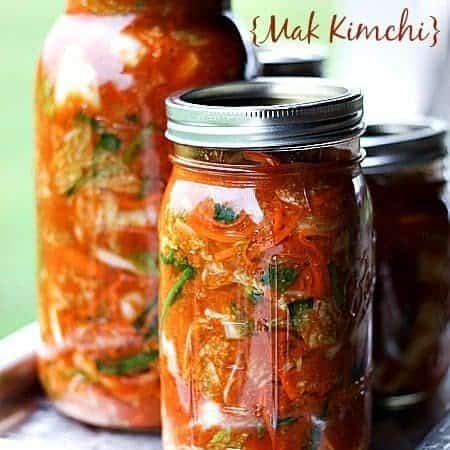
Easy, Fast Kimchi Recipe {Mak Kimchi}
Rate RecipeIngredients
- 3-8 pounds napa cabbage
- 2 bunches green onions trimmed of the root bits
- 2-3 large carrots peeled, thinly julienned
- 1/2 cup kosher salt
- 1/2 cup korean chili powder
- 15-20 cloves garlic overdoing garlic makes this stay on your breath more than usual., peeled
- 4-6 inches ginger peeled, rough chopped
- 1 tablespoon fish sauce
- unsweetened pear juice or unsweetened apple juice
- 4 tablespoons white miso paste
Instructions
- Cut the napa cabbage in half longways, then in half again longways. Cut the core out of the four quarters. Cut the cabbage into squares (about 2-3 inches square), pop it in a bowl with the carrots. Sprinkle with the 1/2 cup kosher salt, massage so everything is coated in salt and starting to soften and wilt. Fill with cold, chlorine free water to cover it well and let it soak for at least 1 1/2 hours.
- Pour the cabbage and carrots and liquid into a strainer. Let the brine drain away.
- Lob off the white bits of the green onions and put them in a food processor with the garlic cloves, ginger, miso paste, and korean pepper powder. Zap it on high ’til it’s smooth-ish. Add in the fish sauce and a couple of slops of pear juice and zap it more until it’s about pancake batter consistency… maybe a bit thinner.
- Put the brined cabbabe/carrots in a big, anti-reactive (glass, enamel, or stainless steel) bowl. Rough chop the green parts of the onions and add those to the cabbage/carrots. Pour the chili paste combo over the cabbage and wear gloves to massage it all over the cabbage/carrots green onions so everything is completely covered.
- Pack super tight in canning jars. CRAM it in there. Add a two-piece lid, but just set the ring in place to hold the lid down without screwing it in place. Place it on a rimmed baking dish to catch any spill-over. Let it sit at room temperature for up to 72 hours, until it is bubbly and fragrant. Once every day, insert a clean chopstick or butterknife to release air bubbles. If needed, pour in some additional brine to keep all the vegetables submerged.
- Store on a rimmed sheet in the refrigerator for up to six months, being sure that the vegetables are submerged the whole time. The older it gets, the stronger it will become.
Notes
Nutrition
Nutritional information is an estimate and provided to you as a courtesy. You should calculate the nutritional information with the actual ingredients used in your recipe using your preferred nutrition calculator.
did you make this recipe?
Make sure to tag @foodiewithfam on Instagram and #hashtag it #foodiewithfamily so I can check it out!
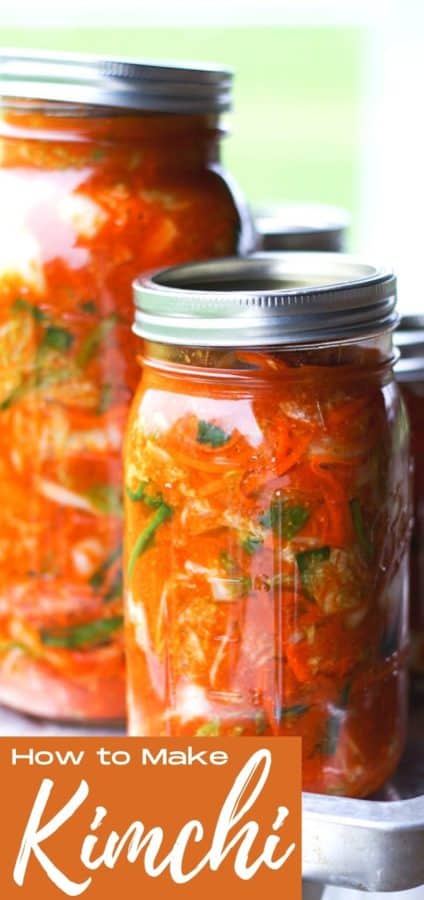
This post was originally published on December 2, 2013 and was updated December 28, 2016, June 2018, and September 2021.
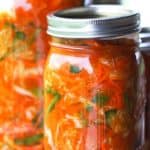



Reader's Thoughts...
Susan says
where are the quantities?
Rebecca says
Hey Susan- If you look at the printable recipe card, all the quantities and such are there!
Susan says
Got it thank you, great recipe and so much fun releasing the bubbles, my house smells amazing. I can’t wait to try the kimchi pancake,
cheers
Jimmy Moore says
Just made my first run of Kimchi using your recipe. Looks great!?
Pchard says
I have followed your recipe twice! It’s perfect and so well explained. 1,000x better and WAY cheaper than store bought.
Rebecca says
Thank you so much for the great rating and letting me know about your successes, Pchard!
LMM says
The recipe instructs to add more brine to the jars if the vegetables are not fully covered. It also states to drain away the brine. Is the brine supposed to be disposed of or saved?
If disposed of is there a recipe for making more brine? If so, please post or send.
Also, should the drained vegetable be rinsed after they’ve been brined?
I’m looking forward to trying out this recipe.
Rebecca says
Hi LMM,
The first brine you want to drain away. If you need to mix up a little more later, just stir 1 tablespoon of kosher salt into 1 cup of cool, unchlorinated water and pour a bit over the kimchi to cover. You do not need to rinse the vegetables after soaking! Happy Kimchi-ing!
John Swanson says
Got to try it
Joe O says
Rebecca,
Thanks for this recipe! We love kimchi but it’s a bit pricey at the rate we go through it.
I usually don’t modify recipes the first couple of times I make them but I did and they were ALL mistakes, well intentioned as they were!
The three things I did that were problematic:
1. I cut the napa too small because in most commercial kimchi I find some of the stem pieces too big. I didn’t realized how much the brining would soften the thinner leaves. Next batch I’m going to cut the thicker stems about 1 inch square but keep the leafy part at the 2 by 3 inches you recommend.
2. I soaked the napa and carrots overnight in the brine since I read (in several other recipes, not yours) that this was a ‘sterilizing’ step to eliminate undesirable bacteria.
Perhaps I didn’t rinse the cabbage well enough but the final product is a little too salty. Perfectly edible but next time I’ll stick to your timing on the brining step.
3. I grated the carrots to save time (also from a different recipe). They are just too thin and flimsy and I would have preferred your method of match-sticking them. I make Vietnamese pickled daikon and carrot (Do Chua) all the time so I know how to do it.
Your recipe was both fast and easy and produce wonderful kimchi. Looking forward to my 2nd batch and many more!
Thanks again!
Lidia says
What a fabulous recipe! Definitely trying this weekend. Thanks Rebecca!
Xx Lidia
Rebecca says
Thank YOU, Lidia!
Bob callioux says
Where do I get extra sauce to top off after 72 hours
Rebecca says
You shouldn’t have to top it off, Bob. It should be creating its own juices as it ferments and bubbles. If you’re finding it is dry, you may need to have it packed more tightly into the jars. You can always use a little salt water brine to cover it, too. Create the brine from 4 cups water and 4 tablespoons kosher or sea salt!
Tami says
thatI know Korean Red Pepper Powder is the main thing, however, I don’t have any. What I do have is a big ol’ tub of Gochu Jang, do you think that would work?
Rebecca says
I haven’t tried it that way, Tami, but I’m betting it would be tasty!
paul says
COol! Thanks for the great recipe. I was just messing around and made some with red miso paste, because I didn’t have any of those tiny fishies. It was/is pretty good. In fact, I have a few extra jars of the sauce in my garage, fermenting. I read somewhere that it starts to smell after a while. Am I going to get in trouble with my wife? Neither one of us is Korean.
THanks again. Fantastic pictures.
Chris clemo says
Hi Rebecca – Got a quick question for you regarding the consistency of my paste and how well it covers up the cabbage after I pack it in my mason jars. I noticed you mentioned something about using extra brine to cover up the cabbage. Does this mean I can use extra salt water to loosen things up and more importantly, cover the contents? I just want to make sure as I’m prepared to stowe these away for fermentation. Thanks for the great recipe. I’m excited to try when ready.
Chris
Rebecca says
Hey Chris! Great question. The paste should be gloppy and quite thick. You don’t really want to loosen things up because the cabbage and carrots are going to give off liquid as they sit and get tasty. The brine is basically to pour over the top in small quantities just to keep everything submerged. You can add a little more if needed as it perks down into the kimchi, but you really don’t want to add much as it will make it taste far too salty.
Chris Clemo says
OK great. I did top each jar off with very little brine just to cover the vegetables enough, but not into mixture of paste itself. It was thick when I mixed it into bulk of the batch. As for the fermentation and bubbling part . . . . I have yet to notice any major activity in regards the bubbles. The jars are sitting in a pan, packed tight with the slaw, at room temp, lids ajar. I just to make sure I’m following protocol
Thanks!
Rebecca says
I think you’re doing fine, Chris! Sometimes it takes a couple of days to let it really start perking around.
Kori Casey says
How can you make it less spicy? I love kimchi, but I can’t handle much spice because I’m a big pansy. I don’t mind a little bit though.
Anita says
I make my own just to avoid MSG.
Rebecca says
Mine contains no MSG, so you’re in luck!
Jennifer says
This sounds delicious…my family prefers milder heat over super spicyness. I know it’s a relative scale, but just how spicy is it? Is it ok to adjust the hot chili pepper content to accommodate milder tastes?
Rebecca says
Hi Jennifer,
Because everyone’s taste buds are different, it’s tremendously difficult to quantify exactly how spicy it is. If I’m speaking from my own perspective it is mild. I tend to like spicy food, so I’m not sure what that says 😀 All that being said, you can certainly adjust the chili pepper without safety concerns.
cara membuat kimchi says
Thankyou for recipe
David says
Can I use regular cabbage I can never find Napa around here?
Rebecca says
I know some folks who have subbed in green cabbage, but I might try special ordering from my local grocery store for the Napa!
Jeanette Mitchell says
Usually at international markets
doug says
I really like your recipe. I made it last week and have enjoyed it in something every day since. The flavor is complex and nicely balanced. I like it a lot; it is better than the commercial Kimchi products I’ve been buying….and that includes a few small batch local producers’ products.
thank you for this recipe!
Kimmie says
Kimchi is also good as a topping to cheese pizza! Can’t wait to try this recipe…..checking my pantry now!
Farzana says
I am on a no sugar diet, will this recipe work without the sugar element?
Rebecca says
I’m not certain which sugar element you mean. The recipe doesn’t call for sugar at all, and the pear juice is unsweetened.
Keyee says
But when you’re on a no sugar diet, fruit is considered to be sugar. So as I recall.. Way back up in the reading, it did mention not putting the pear. All the best. Ty.
Rebecca says
Some level of sugar is desirable when you’re fermenting. It helps maintain a balance of activity and boosts fermentation.
Cindi says
I’m wondering about the pancakes. Do we just stir the kimchi into the batter used to make regular pancakes. That sounds like a really delicious bread/side dish.
Rebecca says
Actually, Cindy, this is the recipe you’d want to use for the Kimchijeon (Kimchi pancakes). It really is magical! https://www.foodiewithfamily.com/kimchi-pancake-kimchijeon/